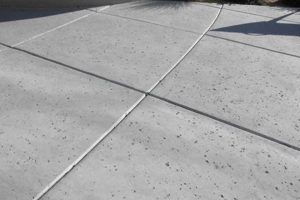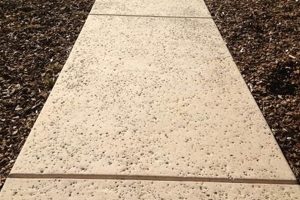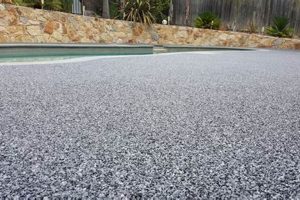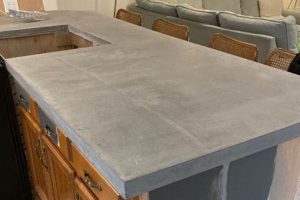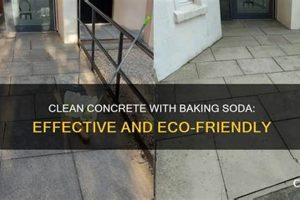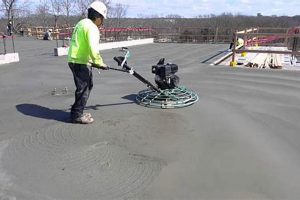A textured surface achieved on concrete, imparted by dragging a broom-like tool across freshly laid concrete before it fully hardens, provides enhanced traction. The resulting subtle ridges create a non-slip surface, frequently utilized in areas prone to wet conditions or pedestrian traffic. Sidewalks and patios serve as typical applications, where safety is a key consideration.
The application offers a practical and cost-effective method to improve safety and aesthetics. It strikes a balance between functionality and visual appeal, adding a tactile dimension while minimizing the risk of slips and falls. Historically, the approach has been a long-standing industry practice due to its simplicity and effectiveness in improving concrete surfaces.
The subsequent sections will delve into specific factors affecting the final appearance and performance, examine ideal applications, and outline best practices for achieving consistent results. This will include a discussion of concrete mix design, timing of the application, and the various types of tools used to create this finish.
Tips for Achieving Optimal Results
The following recommendations ensure a high-quality outcome, maximizing both the aesthetic and functional benefits. Adherence to these suggestions minimizes common issues and ensures a durable, attractive surface.
Tip 1: Time Application Precisely: The optimal time for execution is after the concrete has initially set but is still pliable. Premature application results in tearing, while delayed application leads to insufficient texture.
Tip 2: Select the Appropriate Tool: Different bristle materials and broom sizes produce varying textures. A coarser bristle creates a more pronounced pattern, while a finer bristle yields a smoother finish. The choice depends on the intended application and aesthetic preferences.
Tip 3: Maintain Consistent Pressure: Applying uniform pressure during the dragging process is critical. Inconsistent pressure results in uneven texture, compromising both appearance and traction.
Tip 4: Overlap Passes Strategically: Each pass should slightly overlap the previous one. This overlapping technique prevents visible lines and ensures a consistent, seamless pattern across the surface.
Tip 5: Control Water Content of Concrete: An ideal mix with lower water minimizes shrinkage cracks. Workability should remain high in order to apply a Broom Finish.
Tip 6: Perform a Test Area: Prior to commencing the main project, execute a small test section. This allows for adjustments to technique, tool selection, and timing, ensuring the desired outcome.
Tip 7: Properly Cure the Concrete: Following finishing, proper curing is essential. Adequate moisture retention minimizes cracking and ensures the concrete achieves its full strength and durability.
Implementing these tips can ensure a durable and visually appealing surface. The final outcome benefits from careful planning and execution, maximizing its functionality and longevity.
In the following sections, we will provide information on how to fix failures for the concrete finishing.
1. Texture Uniformity
Texture uniformity refers to the consistency of the pattern imparted onto the concrete surface. Achieving even distribution of the ridges or grooves created by the finishing process is paramount to both aesthetics and functionality. Irregularities in pattern depth or spacing can result in an uneven appearance and inconsistent slip resistance. For example, a sidewalk with sections of varying texture will not only look unprofessional but also pose a variable level of safety for pedestrians, where some areas provide greater traction than others.
The factors influencing texture uniformity range from tool selection to the application technique. Using a worn or damaged broom can lead to inconsistent results. Similarly, varying the pressure or angle during the dragging motion will cause fluctuations in texture depth. In large concrete pours, maintaining a consistent concrete mix and moisture level across the entire surface are essential prerequisites to a uniform finish. A skilled finisher employs consistent, overlapping strokes, ensuring that each pass blends seamlessly with the previous one. The appropriate timing for execution, when the concrete has partially set but is still pliable, is also critical for achieving a uniform outcome.
In summary, achieving a consistent, uniform texture is an integral component. It requires careful attention to detail throughout the entire process, from mix preparation to execution and curing. Variations in texture can diminish the aesthetic appeal and compromise the intended safety benefits. Understanding and controlling the factors influencing texture uniformity is crucial for producing a concrete surface that is both visually pleasing and functionally effective. Addressing inconsistencies during the finishing stage is significantly easier and more cost-effective than attempting remedial measures on hardened concrete.
2. Slip Resistance
Slip resistance is a crucial attribute imparted by a broom finish on concrete surfaces, particularly in areas subject to moisture or pedestrian traffic. The textured surface creates friction, directly counteracting the risk of slips and falls. The degree of slip resistance is proportional to the depth and spacing of the ridges; a more pronounced texture provides greater traction. Consider a sloped driveway: without adequate slip resistance, a smooth concrete surface becomes hazardous when wet or icy. The broom finish mitigates this risk, offering safer traversal. The application, therefore, represents a practical safety measure.
The effectiveness of the application in enhancing slip resistance is governed by various factors, including the type of broom used, the timing of application, and the concrete mix design. A stiff-bristled broom produces a more aggressive texture than a soft-bristled one. Applying the texture at the optimal stage of concrete setting ensures proper bonding and durability. Proper curing also strengthens the surface, maintaining its slip-resistant properties over time. Regulations often mandate minimum slip resistance standards for public walkways and ramps, where a broom finish serves as a common and compliant solution. The selection of appropriate aggregate size may also contribute to the slip resistance, particularly where the aggregate is exposed during finishing processes.
In summary, a broom finish offers a straightforward yet effective method for improving slip resistance on concrete. Its implementation is a preventative measure, enhancing safety across various applications, from residential walkways to commercial spaces. Understanding the interplay between application techniques, material choices, and environmental conditions is vital for maximizing its effectiveness. Regular maintenance, such as cleaning to remove debris and contaminants, helps preserve the slip-resistant characteristics of the textured surface over the long term. The absence of adequate slip resistance poses a tangible safety risk, which a properly executed broom finish can reliably address.
3. Application Timing
Application timing is a critical determinant in the successful execution of a light broom finish on concrete. The window for optimal execution is narrow, occurring after the concrete has undergone initial setting but before it achieves full hardness. Premature application, when the concrete is excessively wet, results in the broom dragging and tearing the surface, obliterating any intended texture. Conversely, delaying the process until the concrete has hardened compromises the ability to impart any meaningful texture, rendering the process ineffective. The correct stage is identifiable by the disappearance of surface sheen and the concrete’s capacity to support light pressure without significant deformation.
The impact of incorrect application timing extends beyond mere aesthetics. If the finish is applied too early, the resulting surface will be weak and prone to crumbling, thus reducing its long-term durability. If applied too late, the lack of texture reduces the slip resistance, rendering the surface unsafe, particularly in wet conditions. Consider a concrete sidewalk poured on a warm day; the setting process accelerates, necessitating a faster application of the broom finish compared to a pour conducted on a cooler day. Experienced finishers constantly monitor the concrete’s setting rate, adjusting their timing based on environmental conditions and the specific concrete mix used.
In conclusion, precise application timing is not merely a procedural detail; it is a fundamental element that dictates the final quality and performance of a light broom finish. Deviations from the optimal timing window can lead to compromised aesthetics, reduced durability, and diminished slip resistance. Understanding and mastering the nuances of concrete setting rates is crucial for achieving a finish that is both visually appealing and functionally sound. Consistent monitoring and adaptive adjustments are hallmarks of proficient concrete finishing.
4. Tool Selection
Effective tool selection is paramount when achieving a desired light broom finish on concrete. The choice of broom significantly influences the texture, aesthetics, and slip-resistance characteristics of the final surface. Improper tool selection can compromise the intended outcome, leading to an unsatisfactory or functionally deficient result.
- Bristle Material
The material of the broom bristles whether natural, synthetic, or a blend dictates the texture imparted onto the concrete. Natural bristles, often softer, produce a finer, less aggressive texture, suitable for decorative applications or areas requiring minimal slip resistance. Synthetic bristles, typically stiffer, create a more pronounced, coarse finish ideal for high-traffic zones or areas prone to wet conditions. The specific context dictates the appropriate bristle material to balance aesthetic preferences and functional requirements.
- Broom Width
The width of the broom influences the efficiency of the finishing process and the uniformity of the texture. Wider brooms cover more surface area per pass, increasing efficiency on large slabs but potentially compromising consistency if not wielded properly. Narrower brooms offer greater control, facilitating intricate patterns or detailed work. A balance between efficiency and precision is crucial when choosing broom width, considering the scale of the project and the desired level of detail in the finish.
- Bristle Stiffness and Density
Bristle stiffness and density are key factors determining the depth and clarity of the broom finish. Stiffer bristles, densely packed, exert greater force on the concrete surface, creating a more pronounced and defined texture. Conversely, softer, less dense bristles produce a subtler, more diffused finish. The desired aesthetic and functional properties of the finished surface should guide the selection of appropriate bristle stiffness and density.
- Handle Design and Ergonomics
The handle design and ergonomics of the broom significantly impact the operator’s comfort and control during the finishing process. An ergonomically designed handle minimizes fatigue, enabling consistent pressure and uniform strokes across the concrete surface. A poorly designed handle can lead to inconsistent results and operator strain. Prioritizing operator comfort and control enhances the quality and consistency of the light broom finish.
Ultimately, the successful execution of a light broom finish relies heavily on informed tool selection. Careful consideration of bristle material, broom width, bristle stiffness, and handle design ensures a balance between aesthetic appeal, functional performance, and operator comfort. The interplay of these factors determines the quality and longevity of the concrete surface, underscoring the significance of appropriate tool selection.
5. Curing Process
The curing process is inextricably linked to the durability and long-term performance of concrete surfaces that have received a light broom finish. Proper curing, the maintenance of adequate moisture content and temperature in newly placed concrete, is not an optional step but rather an essential component of the finishing operation. The broom finish, while providing enhanced texture and slip resistance, does not inherently contribute to the concrete’s strength or resistance to environmental factors. Instead, it is the curing process that allows the concrete to hydrate properly, develop its designed compressive strength, and resist cracking. Without adequate curing, the benefits of the finish are compromised, as the underlying concrete structure is weakened.
A concrete driveway with a light broom finish, for example, may initially appear aesthetically pleasing and provide good traction. However, if the concrete is allowed to dry out too quickly, especially in hot or windy conditions, the surface will be prone to surface crazing, scaling, and eventual cracking. These defects not only detract from the appearance of the surface but also reduce its lifespan, necessitating costly repairs or replacements. Various curing methods exist, including water curing (ponding, spraying), covering with wet burlap or plastic sheeting, and the application of chemical curing compounds. The selection of the appropriate method depends on factors such as the environmental conditions, the size of the pour, and the specific requirements of the concrete mix design. Each of these methods aims to prevent rapid evaporation of moisture from the concrete, allowing the cement to fully hydrate and achieve its designed strength.
In conclusion, the relationship between the curing process and a light broom finish on concrete is symbiotic. The finish provides the desired surface texture, while the curing process ensures the concrete achieves the necessary strength and durability to withstand environmental stressors. Neglecting proper curing negates many of the benefits of the finish, leading to premature deterioration and reduced lifespan of the concrete surface. Therefore, proper curing should be considered as an integral part of achieving a quality and long-lasting light broom finish on concrete.
Frequently Asked Questions
This section addresses common inquiries regarding light broom finishes on concrete, offering concise and authoritative answers to assist in understanding the process and its implications.
Question 1: What constitutes a “light” broom finish as opposed to a standard broom finish?
The descriptor “light” refers to the degree of texture imparted onto the concrete surface. A light application utilizes a finer-bristled broom or a lighter touch, resulting in a subtler, less aggressive texture than a standard finish. This provides adequate slip resistance while maintaining a smoother aesthetic.
Question 2: Is a finish suitable for all concrete applications?
While versatile, it may not be ideal for all applications. Interior floors, where a smooth surface is preferred for cleaning and aesthetics, might not benefit. However, exterior surfaces like walkways, patios, and driveways are well-suited due to enhanced slip resistance.
Question 3: How does climate influence the application and longevity of a finish?
Extreme climates pose challenges. In hot weather, rapid drying can lead to cracking, necessitating diligent curing practices. In freezing conditions, proper sealing is crucial to prevent water intrusion and freeze-thaw damage, preserving the integrity of the textured surface.
Question 4: Can a concrete surface be re-finished with a light broom texture after it has fully cured?
Applying the technique to hardened concrete is not typically feasible. The process is most effective on plastic concrete. Alternatives for existing surfaces include applying a textured overlay or using specialized texturing tools, although these methods may not precisely replicate the original appearance.
Question 5: What maintenance is required to preserve a finish?
Routine cleaning is essential. Removing dirt, debris, and contaminants prevents the buildup of slippery substances and preserves the texture’s functionality. Periodic sealing can further protect the surface from staining and weathering, extending its lifespan.
Question 6: Does a finish add significantly to the cost of a concrete project?
The addition is relatively minimal. The primary cost lies in the labor involved in applying the finish, which is typically a standard part of concrete finishing practices. Material costs are negligible, making it a cost-effective method for improving safety and aesthetics.
Understanding these frequently asked questions provides a comprehensive overview of the technique. Addressing these concerns ensures informed decision-making and proper execution.
The following section will delve into the advantages of selecting this finish for various applications, reinforcing the concepts covered herein.
Conclusion
This examination of light broom finish on concrete has elucidated its practical and aesthetic benefits. From its inherent contribution to slip resistance to its cost-effective application, the technique represents a valuable consideration for a spectrum of concrete projects. The effectiveness hinges on adherence to proper timing, appropriate tool selection, and diligent curing practices, thereby maximizing the longevity and performance of the finished surface.
The judicious use of light broom finish on concrete contributes significantly to safety and visual appeal, underscoring its relevance in both residential and commercial contexts. Further research and refinement in application techniques promise even greater optimization of its inherent advantages, ensuring its continued prominence as a standard practice in concrete finishing.


